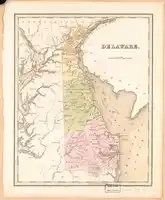
Throughout its history, Delaware has served as a notable crossroads for diverse populations, each leaving an indelible mark on the state’s cultural and demographic landscape. Before European arrival, Indigenous peoples such as the Lenape were the region’s earliest inhabitants. With the onset of colonialism, Delaware’s accessible coastal and riverine locations attracted waves of settlers from the Dutch, Swedish, and English empires, seeking to expand their economic and territorial holdings in the New World. Over subsequent centuries, the forced migration of enslaved Africans, followed by voluntary migration from Ireland, Germany, and Eastern Europe, further shaped the demographic tapestry of the region. These historical movements laid the groundwork for modern-day Delaware, where more recent arrivals—from Southern African Americans during the Great Migration to contemporary Latino immigrants—continue to contribute to the state’s multicultural heritage.
Research your ancestors on MyHeritage
List of Delaware historical migration routesList of Delaware historical migration routes
| Time Period | Ethnic Group | Origination Location | Arrival Location | Motivating Factors |
|---|---|---|---|---|
| Pre-colonial – 17th century | Lenape (Delaware) people | Region surrounding the Delaware River basin | Throughout present-day Delaware | Indigenous presence; ancestral homelands |
| Early 17th century | Dutch colonists | Netherlands | Zwaanendael (near present-day Lewes) | Colonial expansion; fur trading |
| Mid 17th century | Swedish colonists | Sweden | Fort Christina (present-day Wilmington) | Colonial expansion; trade; agricultural opportunities |
| Late 17th century | English colonists | England | Various settlements, eventually controlling the entire region | Expansion of British Empire; economic opportunities |
| 17th – 19th centuries | Enslaved Africans | West and Central Africa | Rural plantations in Kent and Sussex counties | Forced migration; transatlantic slave trade |
| 19th century | Irish immigrants | Ireland | Wilmington and ports along the Delaware River | Escape from famine; industrial and infrastructural jobs |
| Late 19th – early 20th century | German immigrants | Various German states, later unified Germany | Wilmington and nearby industrial centers | Industrial expansion; economic opportunities |
| Early 20th century | Eastern Europeans (Polish, Russian, etc.) | Poland, Russia, and other parts of Eastern Europe | Wilmington; growing factory towns | Industrial labor demand; escape from political/religious persecution |
| Mid – late 20th century | African Americans from the Southern U.S. | Southeastern states | Wilmington, Dover, and surrounding areas | Great Migration; search for industrial/service jobs; better social conditions |
| Late 20th century – present | Latino immigrants (Mexican, Puerto Rican, Dominican, etc.) | Various Latin American countries & Puerto Rico | Wilmington, Dover, poultry plants in Sussex County | Economic opportunities; agricultural and service-sector work |

